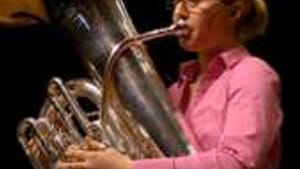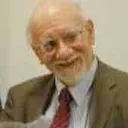Stay in the Loop
BSR publishes on a weekly schedule, with an email newsletter every Wednesday and Thursday morning. There’s no paywall, and subscribing is always free.
Why do I love Temple? Let me count the ways
Temple Orchestra's hidden assets

Samuel Barber's Prayers of Kierkegaard is a major work for chorus and orchestra by a major American composer, and Temple University may be the only Philadelphia institution capable of presenting it without collaborating with another organization. Temple's Boyer College of Music and Dance can unite its chorus with its orchestra and present the Barber work in-house, with an all-Temple cast.
At Sunday's Verizon Hall program, Prayers of Kierkegaard was followed by two intriguing items: a world premiere for an unusual combination of instruments, and Shostakovich's enigmatic Ninth Symphony.
Prayers opens with a setting so straightforward that I was afraid Barber had nodded over his composition paper and turned out a work in which the music doesn't add anything significant to the text. Then the chorus repeated the whole first section in a much more elaborate setting.
Barber revived the idea behind the Baroque operatic arias that began with a simple setting of the text and followed it with increasingly flamboyant repetitions. In his final fourth section, the interweaving of voices and instruments creates an accelerating intensity that climaxes in an orchestral frenzy, dominated by a massive march in the basses.
Leontyne Price's shadow
Barber relieved the choral and orchestral complexities by inserting a soprano aria in the third section. Pei-Ju Yu turned the aria into a gracious, lovely interlude unmarred by any indication that she was intimidated by the knowledge that Leontyne Price sang it at the 1954 premiere.
Temple's choral director, Paul Rardin, led the Barber. The other two works were conducted by the musician who is one of the major reasons I try to attend Temple's orchestral concerts.
Luis Biava headed the Philadelphia Orchestra second violin section from 1984 to 2004 and also served, over the years, as the Orchestra's standby conductor, assistant conductor and conductor-in-residence. He has led Temple's orchestra for 25 years, in addition to guest conducting around the world and filling conducting and artistic director slots in Puerto Rico and Japan.
Painting William Tell
Biava is a sensitive conductor with a marked talent for pulling all the values out of a score. The first time I heard him conduct Temple student musicians, I was startled by the poetic scene painting he drew from the opening of the William Tell Overture. I had assumed Rossini's overworked overture had been scheduled as a student exercise. Biava turned it into a memorable experience.
The premiere on the program was a contribution to one of the rarer musical genres: the concerto for tuba and orchestra. There is something inherently comic about the tuba, and the Philadelphia Orchestra's resident tuba virtuoso, Carol Jantsch, is known for her sense of humor. But she's also a first-class musician, capable of bringing out all the poetry that her instrument can produce in the right hands.
Michael Daugherty's Reflections on the Mississippi opens with a beautiful evocation of the mist rising over the river in the morning, with the tuba setting most of the mood, and continues with inventive bits like duets in which the tuba partners with the violin and the snare drum.
Because I've heard Jantsch play some elaborate arrangements for tuba, I felt Daugherty could have pushed her abilities more than he did (though the soloist herself may disagree). But overall, Reflections on the Mississippi is an appealing work that spotlights a normally underappreciated supporting instrument.
Banned by Stalin
Shostakovich's Ninth Symphony provided another demonstration of Biava's ability to draw a sensitive, glowing performance out of a student orchestra. But like all of Shostakovich's work, it also raised thought-provoking issues.
You don't need to connect Shostakovich's work to his traumatic life under Stalin to enjoy it. He's an ideal composer for contemporary listeners nurtured on literature and drama that emphasize economy, pace, and variety. The Ninth Symphony is a fast-paced parade of moods, musical material, and novel orchestral effects.
But Shostakovich composed all his music under a brutal political system that threatened him with death and imprisonment, and he produced the Ninth Symphony under particularly dangerous circumstances. World War II had ended and Joseph Stalin expected a triumphant, celebratory work from the Soviet composer who had produced the super-patriotic "Leningrad Symphony" during one of the war's darkest hours.
End of the war
Instead, Shostakovich greeted the end of the Great Patriotic War with a work that mingles satiric marches with solemn elegies and a host of less classifiable moods.
The symphony was eventually banned in the Soviet Union, where it remained banned until two years after Stalin's death in 1953. American critics didn't think much of it either.
To me, the symphony captures the complex, clashing emotions evoked by war. You can hear some of the triumphalism that Stalin expected, but it's restrained and subdued by other feelings. The long, elegiac largo is a somber memorial. The mocking march in the scherzo reflects a cynical distaste for the military cheerleading that war imposes on soldiers and civilians alike.
In August of 1945, when I was nine, I joined the adults who poured into the streets in our section of West Haven, Connecticut to celebrate Japan's surrender. I think Shostakovich would have understood their feelings. There was nothing triumphal about that crowd. They weren't celebrating a victory. They were celebrating the end of the war.
At Sunday's Verizon Hall program, Prayers of Kierkegaard was followed by two intriguing items: a world premiere for an unusual combination of instruments, and Shostakovich's enigmatic Ninth Symphony.
Prayers opens with a setting so straightforward that I was afraid Barber had nodded over his composition paper and turned out a work in which the music doesn't add anything significant to the text. Then the chorus repeated the whole first section in a much more elaborate setting.
Barber revived the idea behind the Baroque operatic arias that began with a simple setting of the text and followed it with increasingly flamboyant repetitions. In his final fourth section, the interweaving of voices and instruments creates an accelerating intensity that climaxes in an orchestral frenzy, dominated by a massive march in the basses.
Leontyne Price's shadow
Barber relieved the choral and orchestral complexities by inserting a soprano aria in the third section. Pei-Ju Yu turned the aria into a gracious, lovely interlude unmarred by any indication that she was intimidated by the knowledge that Leontyne Price sang it at the 1954 premiere.
Temple's choral director, Paul Rardin, led the Barber. The other two works were conducted by the musician who is one of the major reasons I try to attend Temple's orchestral concerts.
Luis Biava headed the Philadelphia Orchestra second violin section from 1984 to 2004 and also served, over the years, as the Orchestra's standby conductor, assistant conductor and conductor-in-residence. He has led Temple's orchestra for 25 years, in addition to guest conducting around the world and filling conducting and artistic director slots in Puerto Rico and Japan.
Painting William Tell
Biava is a sensitive conductor with a marked talent for pulling all the values out of a score. The first time I heard him conduct Temple student musicians, I was startled by the poetic scene painting he drew from the opening of the William Tell Overture. I had assumed Rossini's overworked overture had been scheduled as a student exercise. Biava turned it into a memorable experience.
The premiere on the program was a contribution to one of the rarer musical genres: the concerto for tuba and orchestra. There is something inherently comic about the tuba, and the Philadelphia Orchestra's resident tuba virtuoso, Carol Jantsch, is known for her sense of humor. But she's also a first-class musician, capable of bringing out all the poetry that her instrument can produce in the right hands.
Michael Daugherty's Reflections on the Mississippi opens with a beautiful evocation of the mist rising over the river in the morning, with the tuba setting most of the mood, and continues with inventive bits like duets in which the tuba partners with the violin and the snare drum.
Because I've heard Jantsch play some elaborate arrangements for tuba, I felt Daugherty could have pushed her abilities more than he did (though the soloist herself may disagree). But overall, Reflections on the Mississippi is an appealing work that spotlights a normally underappreciated supporting instrument.
Banned by Stalin
Shostakovich's Ninth Symphony provided another demonstration of Biava's ability to draw a sensitive, glowing performance out of a student orchestra. But like all of Shostakovich's work, it also raised thought-provoking issues.
You don't need to connect Shostakovich's work to his traumatic life under Stalin to enjoy it. He's an ideal composer for contemporary listeners nurtured on literature and drama that emphasize economy, pace, and variety. The Ninth Symphony is a fast-paced parade of moods, musical material, and novel orchestral effects.
But Shostakovich composed all his music under a brutal political system that threatened him with death and imprisonment, and he produced the Ninth Symphony under particularly dangerous circumstances. World War II had ended and Joseph Stalin expected a triumphant, celebratory work from the Soviet composer who had produced the super-patriotic "Leningrad Symphony" during one of the war's darkest hours.
End of the war
Instead, Shostakovich greeted the end of the Great Patriotic War with a work that mingles satiric marches with solemn elegies and a host of less classifiable moods.
The symphony was eventually banned in the Soviet Union, where it remained banned until two years after Stalin's death in 1953. American critics didn't think much of it either.
To me, the symphony captures the complex, clashing emotions evoked by war. You can hear some of the triumphalism that Stalin expected, but it's restrained and subdued by other feelings. The long, elegiac largo is a somber memorial. The mocking march in the scherzo reflects a cynical distaste for the military cheerleading that war imposes on soldiers and civilians alike.
In August of 1945, when I was nine, I joined the adults who poured into the streets in our section of West Haven, Connecticut to celebrate Japan's surrender. I think Shostakovich would have understood their feelings. There was nothing triumphal about that crowd. They weren't celebrating a victory. They were celebrating the end of the war.
What, When, Where
Temple University Symphony Orchestra and Combined Choirs: Barber, Prayers of Kierkegaard; Daugherty, Reflections on the Mississippi; Shostakovich, Symphony No. 9 in E Flat Major. Pei-Ju (Peggy) Yu, soprano; Carol Jantsch, tuba; Paul Rardin, choral conductor; Luis Biava, music conductor. March 24, 2013 at Verizon Hall, Kimmel Center, Broad and Spruce Sts. www.temple.edu/boyer.
Sign up for our newsletter
All of the week's new articles, all in one place. Sign up for the free weekly BSR newsletters, and don't miss a conversation.

 Tom Purdom
Tom Purdom